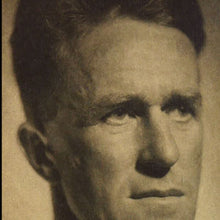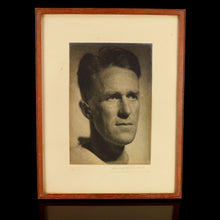TE Lawrence by Howard Coster, London, 1931
Adding product to your cart
Overall: 38cm (15in) x 29.8cm (11.7in)
Silver bromide print. Printed on textured paper, mounted on board. Signed on the mount in pencil by the photographer ‘Howard Coster FRSA / London’. Image: 24.2cm x 16.3cm. Contained in period frame.
On 10 October 1931 T.E. Lawrence, who was then serving in the RAF and developing high speed rescue boats, wrote to Charlotte Shaw, wife of playwright George Bernard Shaw, to relate the circumstances in which the present portrait was made. ‘On Friday I was on the embankment near the Temple when a little bare-headed man rushed up and said “Colonel Lawrence, I want to photograph you”. So I went along for the joke of it and he put me on a little chair at a little shop in Essex Street. Rather a nice little stammering man, I thought. Works for Vogue!”
Read more
Known to the world as 'Lawrence of Arabia', Colonel Thomas Edward Lawrence, CB, DSO, (1888-1935) was born in Tremadoc, North Wales. After Oxford, he journeyed to Syria as an archaeologist (1909-14). In the war against the Ottoman Empire, he advised the future King Faisal, and led the triumphant Arabs into Damascus (1918). He told his story of the war in ‘The Seven Pillars of Wisdom, a Triumph’ (1926). To escape his notoriety, Lawrence changed his name and rejoined the army in 1922 as Gunner JH Ross, and the RAF (1923-35) as Aircraftsman TE Shaw. In ‘The Mint’ (1936) he described the harsh life of the ranks. He was killed in a motorcycle accident.
The photographer Howard Sydney Musgrave Coster (1885-1959) was brought up on the Isle of Wight, served in the RAF during the 1914-18 War, and spent time in South Africa before opening a London studio at 8 / 9 Essex Street, off the Strand, in 1926. Following the example of the American Pirie MacDonald, he specialized in male subjects and styled himself 'Photographer of Men’ to distance himself from the society portraiture of Bond Street. His business was successful from the start, and by the 1930s, Coster had undertaken several commissions from George V and members of the royal family as well as literary figures, such as Isherwood, Auden and Spender. He photographed numerous figures from the worlds of theatre, film and music including Gielgud, Korda, Laughton, and Olivier. In contradiction to his promotional tagline, he also photographed notable women including Vera Brittain, Rebecca West, Radclyffe Hall and Edith Sitwell.
In 1985 the National Portrait Gallery held the retrospective show ‘Howard Coster: Camera Portraits of the Twenties and Thirties’ to mark the centenary of his birth. The accompanying catalogue declared: ‘Coster is perhaps noted for his innovative and dramatic use of lighting. Carefully judged, low-key effects illuminate character and suggest atmosphere in studies … The quality and range of his work in this exhibition confirm Coster as one of the major photographic portraitists of his time.’






